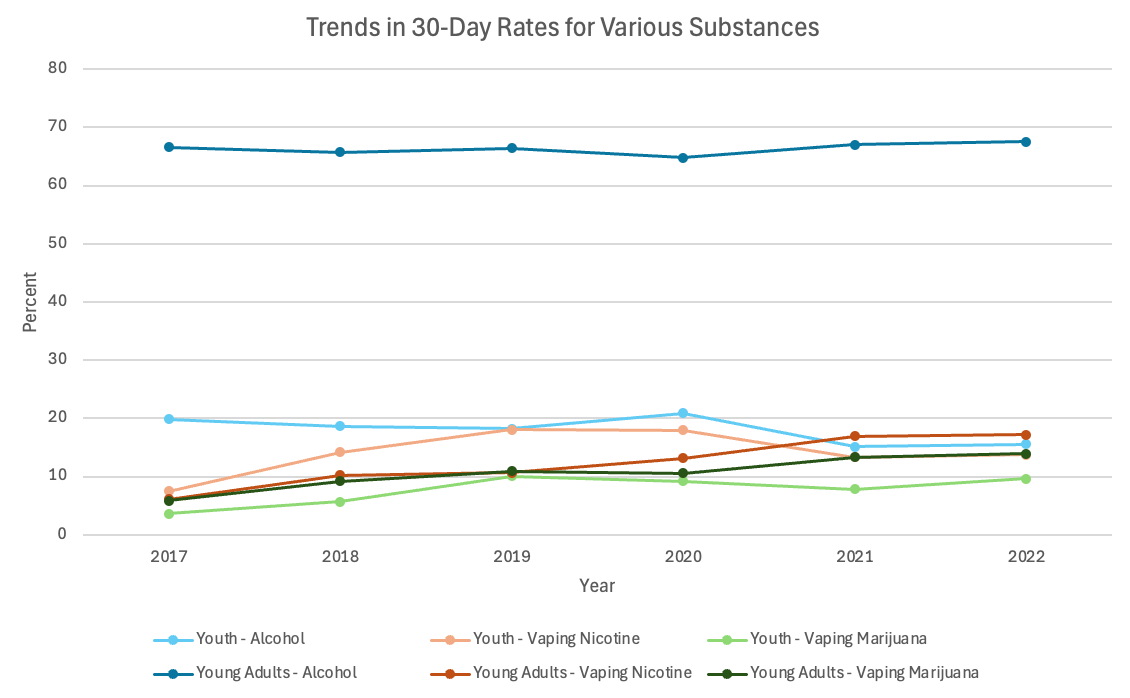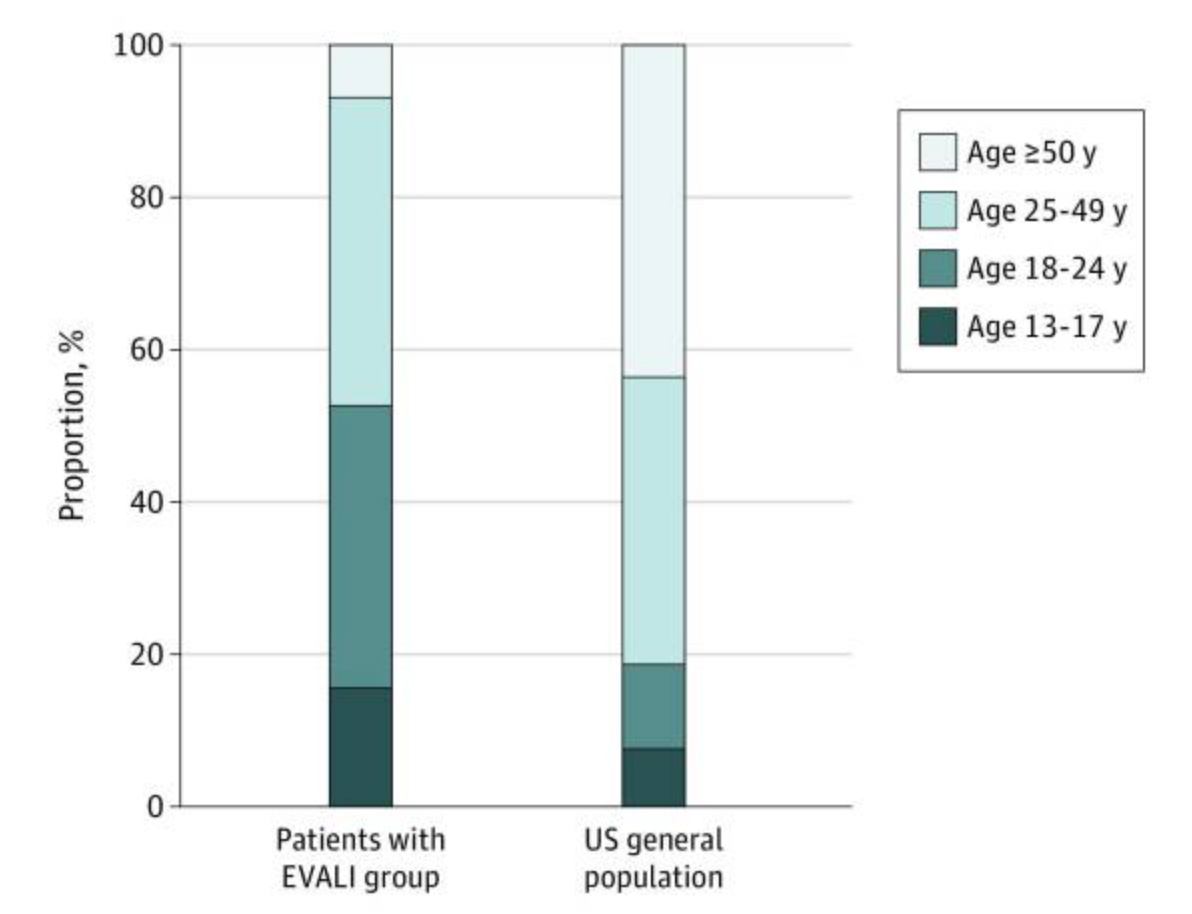Most recent data show that about 10-14% of young people in the US have used cannabis vapes in the past 30 days. It’s more common in areas where recreational use is legal, and it can have negative health effects.
Covering nicotine vaping in previous posts (posts one and two) has answered a lot of questions, but this Nerdy Girl still wanted to better understand cannabis, or marijuana, vaping among young people. Most of the information in this post comes from a scoping review on cannabis vaping and young people, which can be found here: https://tinyurl.com/5ebb2ys9. In this paper, the authors summarize 202 scientific papers on the topic published between 2013 and 2021. Scoping reviews assess the number and breadth of existing studies on a topic (which is especially useful for new areas) but do not evaluate the quality of the studies. Although this is a considerable caveat to our full understanding of the topic, the topic itself is relatively new, and we are making sense of the data as it becomes available to us. This review summarizes information about trends, risk factors, health effects, and marketing of cannabis vaping based on the scoping review.
Trends
First, we’ll discuss the trends. Data from Monitoring the Future (MTF), a nationally representative survey in the US, follows cannabis vaping trends for youth (middle and high schoolers) and young adults (ages 19-30). Past 30-day rates refer to the percentage of people within a specific population who have reported using the product at least once in the past 30 days. For youth, past 30-day rates follow the light green line in the chart below. Rates rose from 3.6% in 2017 to 10.1% in 2019, then decreased to 9.2% in 2020 and to 7.8% in 2021. Rates increased to 9.6% in 2022 (MTF 2022, Table C-3). For young adults, past 30-day rates follow the dark green line in the chart below. Rates increased from 5.9% in 2017 to 10.9% in 2019. Rates decreased to 10.6% in 2020 then rose again to 13.9% in 2022 (MTF 2022, Table/Figure 11). For young people in general, cannabis vaping rates are trending upwards. Cannabis vaping rates for the past 30 days were consistently lower than past 30-day nicotine vaping rates and past 30-day alcohol use between 2017-2022 for both youth and young adults:

Source: MTF 2022 for Youth and Young Adults
Cannabis use is not legal in all US states. As of 2023, 24 states have legalized cannabis for adult recreational use with an additional 14 states allowing medicinal use only. Not surprisingly, overall cannabis use is higher in states where it is legal. Evidence about the effect of legalization on cannabis use among young people is mixed (based on the evidence we have). One study found no effect of legalization on underage youth’s ability to obtain cannabis. Other studies have shown an increase in multimodal cannabis use (such as smoking, vaping, and ingesting) among underage youth following legalization.
Risk Factors
Several studies looked at factors associated with a greater likelihood of cannabis vaping among youth, finding higher rates for male sex, younger age (i.e., under age 30), Hispanic and Black Americans compared to White Americans, and people with higher income and education. These factors highlight the diverse demographic characteristics associated with cannabis vaping.
Some of the reasons youth and young adults report vaping cannabis include: vaping cannabis is safer, healthier, and/or less physically irritating compared to cigarettes or combustible tobacco; to reduce or quit smoking tobacco products; to control the dosage of THC consumed; and experimentation, among others. Understanding these risk factors and motivations is crucial for developing targeted interventions and public health strategies to address cannabis vaping among youth and young adults.
Health Effects
One of the acute health effects caused by cannabis vaping is e-cigarette, or vaping, associated lung injury (EVALI). EVALI is most commonly caused by exposure to vitamin E acetate, an ingredient in some cannabis vaping products (although there are some reports of EVALI being caused by nicotine vape products as well). EVALI can cause cough, difficulty breathing, nausea, diarrhea, fever, chills, and weight loss. The CDC collected information on EVALI cases from the summer of 2019 through February 2020, and there were 2,807 reported EVALI cases in the US during that time. It is hard to interpret this risk because we don’t know how many people overall used cannabis vapes in the same time period (that is, the denominator). A different study published in 2020 looked at data from the CDC and reported demographic trends, which showed that youth and young adults make up almost half of the EVALI cases, as shown below.

Risk factors for EVALI include younger age (i.e., under age 25, as shown in the above chart), higher frequency of cannabis vaping, the use of Dank Vapes (a brand of vapes), and using products from informal sources (i.e., not from a dispensary or other regulated source). This review did not include information about the possible long-term health effects of cannabis vaping. This type of product is relatively new, so it’s not something we know much about at this point.
Other health effects of cannabis products in general that are not limited to young people include cannabinoid hyperemesis syndrome, impaired coordination and judgment, anxiety, high heart rate, dry mouth, suicidal thoughts, and psychotic symptoms. Investigation into associations between cannabis and suicidality and between cannabis use and psychotic symptoms is ongoing but may be particularly concerning for youth. Long-term cannabis use can lead to dependence. Data about cannabis vaping leading to dependence among young people and about other health effects, like cannabis-impaired driving, are not available.
Conclusion
Cannabis vaping is a relatively new phenomenon, and we are still learning what it means for health compared to other risk factors young people face. While cannabis vaping rates in youth have been increasing, the rates are still lower than other substance use behaviors, like nicotine vaping or alcohol use, and may not be as concerning as these other behaviors. As laws around cannabis continue to change, it’s important to continue researching its use and health effects to inform people about the potential risks.
This is the third in a series of posts about vaping. We posted recently about the tradeoffs of using vapes versus combustible cigarettes and nicotine vaping trends among young people. Please put your questions about vaping in our question box.
Stay safe, stay well,
Those Nerdy Girls
#ThoseNerdyGirls
Further Reading:
Monitoring the Future Annual Report 2022 among adults ages 19-60
Monitoring the Future Annual Report 2022 among secondary school students
The EVALI and Youth Vaping Epidemics — Implications for Public Health
More states are regulating marijuana. See where it’s legal across the country – CNN


